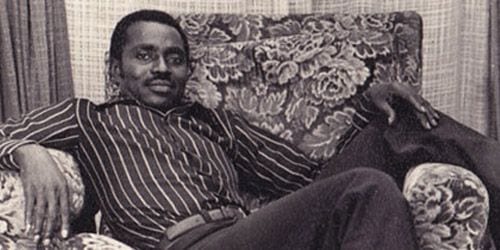
At the heart of Legends of Benin lies the spiral, the curve, the unfinished circle that leads to its replica. The silence at the start of the album is broken by the sound of a drumbeat, but this forward movement is eventually joined by a guitar, which introduces the spiral, and that’s that for the rest of the album — the spiral is there. Percussion shuffles; men shout, “yow!“; keyboards sprout rills of ice; horns proudly serenade singers; but through it all, this insidious curving tickle of noise goes on, always proposing an end and never reaching it. This sets it apart from the guitar chords of rock music, all beginnings and endings, stamping on the stage with one foot and declaring, “I’m here!” The West African guitar fills the middle ground of the song, and there’s nothing the other instruments can do to get away from it. The whole sound, spiral and everything else, comes together in a fat stew, stirring round and round and rising up and up.
Sometimes it seems that in listening to music made in different parts of Africa from about 1950 to 1990 that this spiral is, or has been, the musical shape that pulls the continent together. It’s in West African music, like the Beninese songs here, and it’s present across the continent in Kenyan benga — and there are songs on this album that owe something to Kenya, too — and down toward the middle, in the Congo and in Zimbabwe, as well as Analog Africa demonstrated in 2007 when it re-released tracks from the Green Arrows and the Hallelujah Chicken Run band. With last year’s African Scream Contest Samy ben Redjeb’s attention shifted from the south of the continent to the west, but the spiral has come with it. And it’s a joy, as it was when those two Zimbabwean albums came almost out of nowhere, to hear crate digging done so well, with such verve and good judgment. Legends of Benin is a solid piece of work.
The spiral ripple gives this compilation the thrust of a shifting muscle, and it’s noticeable in the care that has been taken to ensure the listener isn’t overwhelmed by one type of noise, that no single musician or band gets to monopolize our ears or that we’re never left to overdose on, for instance, El Rego’s James Brown catalogue of heh‘s and ha‘s. His songs have been buffered by others so that he seems fresh and welcome whenever he arrives. The music is rich with small moments of invention. About six minutes and 15 seconds into “Okpo Videa Bassouo”, the singer Gnonnas Pedro emits a trembling, “ah-ah!”, as if he might be able to pass out under the weight of the energy his band has let loose. On “Tin Lin Non”, Honoré Avolonto stands aside from a chanted monologue to let a keyboard come in and fart at him for a few moments; then he resumes the monologue. Back in “Honton Soukpo Gnon”, Antoine Dougbé sings a honeyed chant in French. The neatness of Dougbé’s “Nou Akuenon Hwlin Me Sin Koussio” ends in tangled overlap. Some songs are Afrobeat; others sound like the basic elements of Afrobeat arranged in a different order.
The delicacy with which the playlist has been assembled is evident at the end when the compilation reaches a climax in the rat-a-tat drums and horns of Dougbé’s “Kovito Gbe De Towe” then floats us out the door on “La Musica en Verite”. The last song invites us to relax, as Pedro returns, curling his tongue around French, and the keyboard player of the Dadjes Band makes his instrument hum so finely you’ll mistake it for a backing singer. The song assures us “la musica” is important, good and vital; it then takes us by the hand and glides us sweetly toward the exit, a flawless goodbye.

![Call for Papers: All Things Reconsidered [MUSIC] May-August 2024](https://www.popmatters.com/wp-content/uploads/2024/04/all-things-reconsidered-call-music-may-2024-720x380.jpg)



